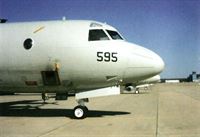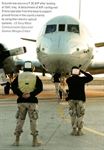Фотографии
-
This view of an EP-3E electronic reconnaissance aircraft shows many of its antennae to advantage. The EP-3E force is being expanded to 16 examples to maintain an airborne signals intelligence collection capability until the aircraft is replaced, beginning in 2019, by whatever type is selected for the EPX programme.
Самолёты на фотографии: Lockheed EP-3 - США - 1969
-
Twenty-five P-3Cs were put through the Block Modification Upgrade Program (BMUP). The nose-mounted ASX-6 electro-optical turret (L-3 WESCAM MX-15) shown here replaced the AAS-36 infra-red sensor.
Самолёты на фотографии: Lockheed P-3 Orion - США - 1958
-
A P-3C upgraded to BMUP standard is shown fitted with the APS-149 active electronically scanned radar, the main component of the Littoral Radar Surveillance System (LSRS) which entered service in 2005. The LSRS features a moving target indication capability. Sixteen BMUP aircraft have been modified to deploy the seven LSRS systems.
Devoid of any unit markings, US Navy P-3C 161126 '126' is seen departing RAF Mildenhall, Suffolk, on April 19, 2007 whilst returning home from the Persian Gulf after a two-month deployment. Note the long canoe-shaped fairing under the fuselage, which houses the Littoral Surveillance Radar System (LSRS). The aircraft had passed through Mildenhall on its way out to the Gulf on February 14, but did not have the LSRS pod attached at that time. After some years of development in the US, it is only within the last six months that the LSRS has been seen deployed operationally on P-30s in the Middle East, with at least six different aircraft noted flying with the pod.Самолёты на фотографии: Lockheed P-3 Orion - США - 1958
-
Most Orions wear low-visibility markings these days, though this P-3C AIP, 159507 of VP-47 is a rare exception. The AIP version has been widely used for electro-optical reconnaissance and targeting in Iraq and Afghanistan (using a nose-mounted retractable L-3 WESCAM MX-20 turret - called the ASX-4 by the US Navy). The thimble ESM radome under the aft fuselage is the most obvious identifier of an AIP P-3C.
Самолёты на фотографии: Lockheed P-3 Orion - США - 1958
-
Groundcrew secure a P-3C AIR after landing at Tallil, Iraq. A detachment of AIP-configured Orions operates from this base to support ground forces in the country mainly by using their electro-optical systems.
Самолёты на фотографии: Lockheed P-3 Orion - США - 1958
-
A P-3C Update 11.5 on finals to land at the US airbase at Mildenhall in the United Kingdom. This aircraft's nose number - normally the last three digits of the an aircraft serial Bureau number - belongs to an NP-30, indicating that this P-3C is most likely a specialised reconnaissance and research aircraft assigned to VPU-1.
Самолёты на фотографии: Lockheed P-3 Orion - США - 1958
-
A sensor operator monitors the electro-optical, radar and ESM systems onboard a P-3C AIR aircraft during an Operation Enduring Freedom mission. In the current conflicts, waged mostly overland, these sensor systems have superseded acoustic sensor systems in terms of importance.
Самолёты на фотографии: Lockheed P-3 Orion - США - 1958
Статьи
- News: Headline, Military, Civil
- B.Hales-Dutton - Etihad Revs up for Growth /Commercial/
- B.Read - Battle of Airliners. Airbus A350 Vs Boeing 787 Dreamliner /Commercial/
- D.Carrara - Cleared Hot. Forward Air Control /Military/
- D.Carrara - Eurofighter On Alert In Austrisa /Military/
- D.Hobbs - Gloster Meteor /Aircraft profile/
- H.-P.Grolleau - EC725. Son of Cougar /Military/
- J.Winchester - Raytheon Sentinel R1 /Aircraft of the RAF/ (5)
- M.Hirst - Don't Be A Drag. Fit Winglets /Commercial/
- P.van den Hurk, E.Roelofs - Italy's Guardians - the Guardia di Finanza /Military/
- R.Burgess - Hunter Over Land And Sea. US Navy P-3 Orions /Military/
- T.Spruce - Delivering the Dream /Commercial/






